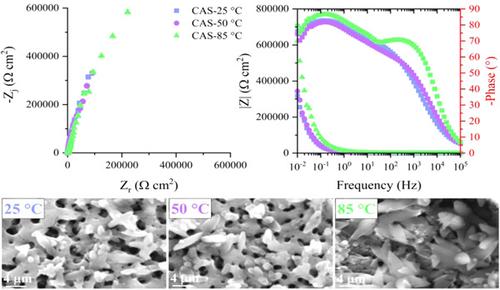当前位置:
X-MOL 学术
›
Mater. Corros.
›
论文详情
Our official English website, www.x-mol.net, welcomes your
feedback! (Note: you will need to create a separate account there.)
Sealing of porous titanium oxides produced by plasma electrolytic oxidation
Materials and Corrosion ( IF 1.6 ) Pub Date : 2021-07-12 , DOI: 10.1002/maco.202112612 Luca Casanova 1 , Nicola Belotti 1 , MariaPia Pedeferri 1 , Marco Ormellese 1
Materials and Corrosion ( IF 1.6 ) Pub Date : 2021-07-12 , DOI: 10.1002/maco.202112612 Luca Casanova 1 , Nicola Belotti 1 , MariaPia Pedeferri 1 , Marco Ormellese 1
Affiliation

|
Plasma electrolytic oxidation is a powerful technique allowing the formation of ceramic coatings with a high degree of functionalization. Plasma–chemical interactions, resulting from the application of a high voltage in a conductive electrolyte, like 0.5 M NaOH, favor the development of a porous surface, which deserves to be sealed to obtain proper corrosion resistance. In the present work, the effect of temperature employed during sealing in calcium acetate is investigated, finding 85°C as an optimum temperature to allow pores closure. Furthermore, a comparison with sealing performed in hot water is presented, which demonstrated similar sealing efficiency. Scanning electron microscope and electrochemical impedance spectroscopy are the tools selected to investigate sealing effects. Impedance spectra are fitted according to feasible electrochemical equivalent circuits finding two-time constants when applied to sealed samples indicative of the presence of barrier and porous layer, respectively.
中文翻译:

等离子电解氧化产生的多孔氧化钛的密封
等离子电解氧化是一种强大的技术,可以形成高度功能化的陶瓷涂层。由于在导电电解质(如 0.5 M NaOH)中施加高电压而产生的等离子体-化学相互作用有利于多孔表面的形成,该表面应该被密封以获得适当的耐腐蚀性。在目前的工作中,研究了在醋酸钙中密封过程中采用的温度的影响,发现 85°C 是允许孔闭合的最佳温度。此外,还介绍了与在热水中进行密封的比较,这证明了类似的密封效率。扫描电子显微镜和电化学阻抗谱是研究密封效果的工具。
更新日期:2021-07-12
中文翻译:

等离子电解氧化产生的多孔氧化钛的密封
等离子电解氧化是一种强大的技术,可以形成高度功能化的陶瓷涂层。由于在导电电解质(如 0.5 M NaOH)中施加高电压而产生的等离子体-化学相互作用有利于多孔表面的形成,该表面应该被密封以获得适当的耐腐蚀性。在目前的工作中,研究了在醋酸钙中密封过程中采用的温度的影响,发现 85°C 是允许孔闭合的最佳温度。此外,还介绍了与在热水中进行密封的比较,这证明了类似的密封效率。扫描电子显微镜和电化学阻抗谱是研究密封效果的工具。











































 京公网安备 11010802027423号
京公网安备 11010802027423号